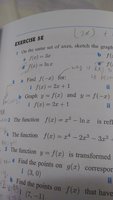You are using an out of date browser. It may not display this or other websites correctly.
You should upgrade or use an alternative browser.
You should upgrade or use an alternative browser.
IB-why is it that f(x)=2x+1 intercepts y at 0.5,not 1?
- Thread starter Leah5467
- Start date
Harry_the_cat
Elite Member
- Joined
- Mar 16, 2016
- Messages
- 3,779
Are you asking about Q2a(i)?
If f(x) = 2x + 1, then f(-x) = 2(-x) + 1 = -2x +1.
In relation to the title of your post:
f(x) = 2x + 1 does intersect the y-axis at 1.
I'm not exactly sure what your question is
If f(x) = 2x + 1, then f(-x) = 2(-x) + 1 = -2x +1.
In relation to the title of your post:
f(x) = 2x + 1 does intersect the y-axis at 1.
I'm not exactly sure what your question is
Dr.Peterson
Elite Member
- Joined
- Nov 12, 2017
- Messages
- 16,873
The problem is,
Please explain why you wrote f(x)=2x and f(x)+1. (I'm guessing that you are not recognizing that f(x) has a specific meaning in this problem, and are just writing "f(x)" to mean "what I've done so far".) It looks like you're trying to solve a different problem than what you showed.
All you have to do for this problem is to replace x in 2x + 1 with (-x).
Now, it is true that 2x + 1 = 2(x + 0.5); but why would you do that in this problem? That is f(x), not f(-x), and it doesn't help toward the answer.Furthermore, the y-intercept of f(x) = 2x + 1 is 1, regardless of which way you write it.
Find f(-x) for f(x) = 2x + 1.
Please explain why you wrote f(x)=2x and f(x)+1. (I'm guessing that you are not recognizing that f(x) has a specific meaning in this problem, and are just writing "f(x)" to mean "what I've done so far".) It looks like you're trying to solve a different problem than what you showed.
All you have to do for this problem is to replace x in 2x + 1 with (-x).
Now, it is true that 2x + 1 = 2(x + 0.5); but why would you do that in this problem? That is f(x), not f(-x), and it doesn't help toward the answer.Furthermore, the y-intercept of f(x) = 2x + 1 is 1, regardless of which way you write it.
HallsofIvy
Elite Member
- Joined
- Jan 27, 2012
- Messages
- 7,760
The line y= 2x+ 1 intercepts the y-axis at the point (0, 1). It intercepts the x-axis at the point (1/2, 0). You may be confusing the two.
Harry_the_cat
Elite Member
- Joined
- Mar 16, 2016
- Messages
- 3,779
HallsofIvy, typo? x-intercept is (-1/2, 0)
Harry_the_cat
Elite Member
- Joined
- Mar 16, 2016
- Messages
- 3,779
OK. Let's step you through this.
f(x) =2x +1 is a straight line with a y-int of 1 and an x-int of -1/2. Correct?
f(x) =2x +1 is a straight line with a y-int of 1 and an x-int of -1/2. Correct?
Harry_the_cat
Elite Member
- Joined
- Mar 16, 2016
- Messages
- 3,779
In general, how does the graph of y=f(-x) compare with the graph of y=f(x) for any function? That is, what transformation does the original graph undergo?
Harry_the_cat
Elite Member
- Joined
- Mar 16, 2016
- Messages
- 3,779
Yes exactly. So if the original line f(x) = 2x+1 has an x-intercept of -1/2, what is the x-intercept after the line has reflected in the y-axis?
Draw a quick sketch if you need to.
Draw a quick sketch if you need to.
Harry_the_cat
Elite Member
- Joined
- Mar 16, 2016
- Messages
- 3,779
Yes the line f(x) =2x+1 was reflected in the y-axis.
The x-intercept of f(x)=2x+1 is found by substituting y=0.
The x-intercept of f(-x) can be found in one of 2 ways:
1. f(-x) = 2(-x)+1 = -2x+1 and substitute y=0 to find x-int is 1/2
OR
2. Recognise that f(-x) is a reflection of f(x) in the y-axis, so the original x-int of -1/2 gets reflectd onto the x-int of 1/2.
The x-intercept of f(x)=2x+1 is found by substituting y=0.
The x-intercept of f(-x) can be found in one of 2 ways:
1. f(-x) = 2(-x)+1 = -2x+1 and substitute y=0 to find x-int is 1/2
OR
2. Recognise that f(-x) is a reflection of f(x) in the y-axis, so the original x-int of -1/2 gets reflectd onto the x-int of 1/2.

